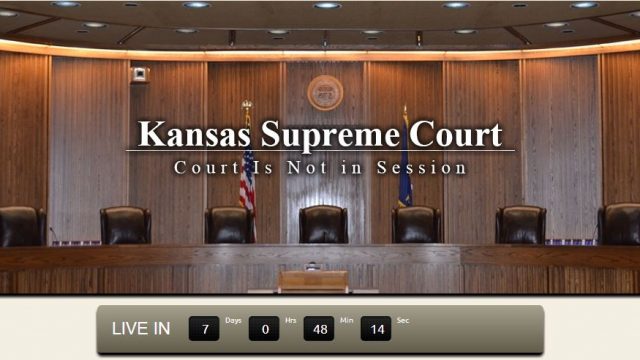KS Judiciary outpaces Legislature in technological transparency

COUNTDOWN: The Kansas Supreme Court is entering its second year of streaming judicial proceedings live online, which can be viewed by anyone with an Internet connection.
By Travis Perry │ Kansas Watchdog
OSAWATOMIE, Kan. — In terms of online accessibility and openness, the Kansas Legislature and state Supreme Court are practically polar opposites.
So much so, in fact, that Topeka‘s SW 10th Avenue, the dividing line between the two governmental entities, might as well be an innovation firewall.
Under the Capitol dome, we have a Legislature that counts itself among only a handful of states that have failed to offer some form of live video to the general public, according to a recent survey conducted by the National Conference of State Legislatures. Kansas only streams live audio from the House and Senate chambers.
Yet just across the street, the Kansas Judicial Center is entering its second year of live-streaming video coverage of Supreme Court oral arguments over the Internet, opening up an important facet of state government to anyone with a broadband Internet connection, rather than the select few who can make the trip to Topeka.
The reasoning, said court public information director Lisa Taylor, is pretty basic.
“I think this was something that was of interest to a lot of individuals,” Taylor said. “The court has always been interested in being open and transparent to the people of Kansas with the work that it does. It’s very difficult when you’re in one location to reach the people of Kansas with the work that you do.”
Taylor, who has served as the court’s public information officer for the past few months, spoke with IT staff and her predecessor, Ron Keefover, about specifics in the court’s push for online video. She declined Kansas Watchdog‘s request to speak directly with the people involved.
Since August 2012, the court has made a slew of video events available for live online viewing, even going so far as literally counting down the seconds until the camera flips on and detailing a list of upcoming broadcasts.
The most recent showing was of Caleb Stegall‘s appointment to the Kansas Court of Appeals on the afternoon of Jan. 3. Chief Justice Lawton Nuss will again make use of the video tech installed in the Supreme Court room during his upcoming State of the Kansas Judiciary address on Jan. 22, a first for the Sunflower State.
While the broadcasting capability was the end result of a planned audio upgrade a few years ago, Taylor said it has been a goal since the court implemented audio streaming in 2004. In all, the video installation cost about $12,000, a figure Taylor said was particularly attractive because the upgrade worked in conjunction with existing audio tech by “enhancing what was already in place.”
By contrast, while the Kansas Capitol is wired to offer video of government goings-on, it’s an idea that has gone out of favor and feasibility. Legislative IT director Jim Miller told Kansas Watchdog last year that while the matter was a priority for his predecessor, it has since fallen prey to re-aligned priorities and a strained state budget.
To be fair, the state Capitol building is a different kind of animal than the state Supreme Court room. The judicial branch was only concerned with equipping a single location with broadcasting capabilities, whereas state lawmakers meet in a litany of rooms spread throughout a huge building.
Lawmakers have called for a cost-study to review the feasibility of implementing online video under the dome. Commissioned in April 2013, officials optimistically said it would be completed in short order, but nine months later the study still has yet to be released to the public. In November, House Speaker Ray Merrick‘s spokeswoman Rachel Whitten cited other duties assigned to legislative IT staff as cause for the delay.
While audio was a good first step for the court, Taylor said ultimately it wasn’t the best form of broadcasting government activities.
“With audio, you have to be keenly aware of the sounds and voices of how people sound, but with video you can see the video and know who the speaker is at any point in time,” she noted.
“It’s always a challenge to make the people of Kansas aware of what you’re doing and what your relevance is, and this really opens a door to anyone who’s interested to see what the court does when it meets,” Taylor added.
Related: Camera shy: KS legislators sidestep transparency
Related: Eye in the sky: Kansas legislative leader won’t require streaming video
Contact Travis Perry at travis@kansaswatchdog.org, or follow him on Twitter at @muckraker62. Like Watchdog.org? Click HERE to get breaking news alerts in YOUR state!
The post KS Judiciary outpaces Legislature in technological transparency appeared first on Watchdog.org.







